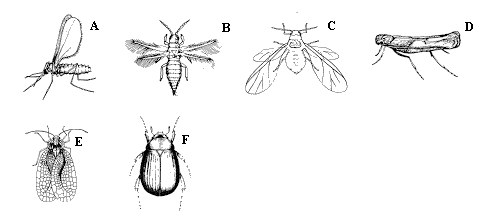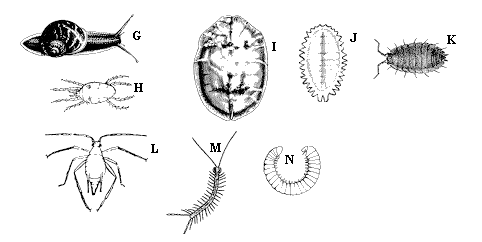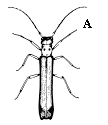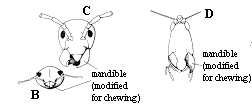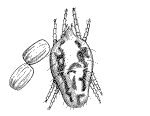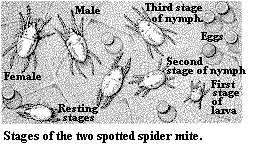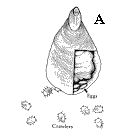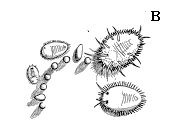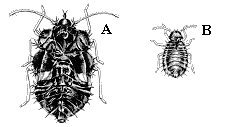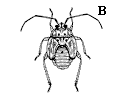The plant boom of recent years has spawned a renewed interest in the home landscape. As the number of certified nurseries in the Southeast increases, an increasingly diverse array of ornamental plants is finding its way into both the home yard and the commercial landscape. Although many contractors and weekend gardeners expect shrubs to be relatively maintenance-free, they often realize too late that each plant in the landscape is the favorite food of some menacing insect or mite pest.
Fortunately, insect and mite pests are not usually fatal to their shrub hosts. In fact, it often takes several years for damage by scale insects, mealybugs, and other sucking insects to become noticeable. Pest populations may go unobserved for years, flair up suddenly, and then recede again. For the homeowner and the commercial landscape maintainer, the complete eradication of a pest species often is not vital to the continued beauty of a landscape. Only in a commercial nursery, where the grower has a responsibility to provide uninfested plants to the public, should an earnest attempt be made to kept nursery stock completely free of noxious plant pests.
Minor insect damage may be easily mistaken for a disease, drought, or fertilizer problem. The symptoms can be strikingly similar: chlorosis, wilting, and die-back; as a result, it is not uncommon for insect pests to inflict extensive damage before their presence is realized. Therefore, the firs step toward the alleviation of the problem must be the first step toward the alleviation of the problem must be pest identification. It is for this purpose that descriptive keys to insect and mite life stages are provided in this introductory section.
Control of Insect and Related Pests
Information concerning the type of pest, its feeding habits, and its life cycle remains essential in determining the appropriate insecticide to use as well as the rate and method of application that will achieve satisfactory control. Since not all insects and mites are a threat to plants, a suspected pest will occasionally be recognized as a harmless or even beneficial species. Consequently, the information within this volume is geared to pest identification and responsible control decisions.
Types of Pesticides
Insect feeding habits determine, to some extent, the type of control chemical used. Pesticides can be classified as stomach poisons, contact-residuals, or fumigants; only the first tow groups will be discussed here. Fumigants must be used in enclosed areas and have very little application to landscape maintenance or typical commercial nursery conditions.
Chewing insects, such as caterpillars, beetles, and grasshoppers, are the targets of stomach poisons. A diverse array of botanical, organic, and inorganic chemicals make up this group. Stomach poisons must be ingested to kill pests. Since piercing-sucking pests (aphids, mites, leafhoppers, etc.) feed below the plant surface, they may avoid contact with stomach poison pesticides. However, contact-residual chemicals, such as malathion, kill a wider range of pests. Such chemicals poison insects or mites that crawl on treated surfaces, eat treated leaves, or are sprayed directly.
The length of time a pesticide lasts depends to some extent on the chemical group to which it belongs. Materials like the plant-derived pesticide pyrethrin may last less than 1 hour, although similar synthetic pesticides are now being made that linger considerably longer. In general, an insecticide classified as a chlorinated hydrocarbon is long-lasting. A good example is chlordane, which is applied to the soil for termite control. Such a treatment may be effective for several decades. The majority of pesticides recommended for insect and mite control on shrubs belong to the related organophosphate and carbamate groups. Less persistent than chlorinated hydrocarbons, most organophosphates and carbamates do not remain effective for more that 1 to 4 weeks. Many of the organophosphates and carbamates are systemic and may give 6 or more weeks of residual activity in treated plants.
Information on toxicity to man, formulations, chemical groups, and mode of action for most insecticides labeled for insect control on shrubs is given in the following table. Pesticides listed in this table can be used for controlling pests of shrubs. This listing is not to be used as recommendations for control but as an aid to better understand the use and classification of pesticides. For proper chemical recommendations, see the current state extension service recommendations. For current pesticide recommendations, see the North Carolina Agricultural Chemicals Manual.
When to Treat
Frequently the homeowner and commercial landscape maintainer are faced with the difficult question of whether or not to spray. Unfortunately, there are no pat answers. A decision of this type requires the careful consideration of several factors. Some of these 1) the type of damage the pest causes, 2) the size of the pest population, 3) the pests's stage of development, 4) the location of the pest on the plant, 5) the cost of control, and 6) the consequences if no control effort is made.
Once it is established that an insect or mite is a pest, pertinent information concerning its habits and life history should be explore. For example, find out if it has chewing or sucking mouthparts, at which stages it is destructive, the number of generations it has each year, its favorite food, and the extent to which it is protected by the plant. This information should suggest when, how, and whether or not the pest can be controlled.
Whether or not the pest should be controlled depends largely on the size of the population. Often low numbers of pests on shrubs pose little treat. However, once populations reach a certain level, control measures become necessary. This level, or "aesthetic threshold," varies greatly from pest to pest, and in most cases it depends upon the plant's placement in the landscape and the fastidiousness of the landscaper. For example, 1 to 20 caterpillars per shrub may cause serious defoliation, whereas 10 to 20 aphids would hardly be noticed. Yet the ahphid's reproductive capacity is so great that they may number in the thousands a week or so later. Therefore, certain pests should be controlled at the first sign of their presence because the will likely increase in number and cause considerable damage. On the other hand, with some pests and on certain plaints, infestations should be watched closely and treated only if the injury gets progressively worse. A camellia heavily infested with tea scale near a walkway might warrant treatment, whereas a similarly infested camellia that is ordinarily viewed from 30 feet might not need treating.
How to Treat
A person may take the time and trouble to spray his plants only to be disappointed with the results. Although the chemical is usually blamed, this conclusion is rarely well founded. As a matter of fact, errors in pesticide application, such as improper storage, improper timing, and wrong concentration, most often account for apparent pesticide failure. The best, most expensive insecticide will produce poor results unless it is applied thoroughly and at the proper time. To be most effective, the pesticide must be applied when pests are present and vulnerable, and at the proper rate in sufficient gallonage to permit thorough coverage of the upper and lower surfaces of the leaves and branches. However, even a well-timed and through application is likely to be a failure if the correct pesticide is not used. Since few insecticides control all insects and mites, carefully check the label to make sure the chemical in hand is registered to control the problem pest.
Environmental conditions also affect the efficacy of a pesticide application. At temperatures below 10°C (50°F) or above 35°C (9°F), insecticides may lose some of their activity. Therefore, applications other than dormant oils are usually not recommended in winter. Warm weather applications are best made in early morning or late evening when the wind is still and the temperature cool.
Shrubs may be reinfested by a resurgence of the original pest population or by other flying insects. Even if a large percentage of pests in an infestation is killed, those remaining may rebuild the population to damaging levels. Such an occurrence is not unusual, since most insecticides applied to shrubbery last only 1 to 7 days. Therefore, recommendations often emphasize repeated applications at specific intervals to eliminate the pests.
Last of all, improper pesticide storage is a possible contributor to pesticide inefficacy. Insecticides and miticides tend to degrade over a period of time once they have been opened. This problem may be common for the homeowner who purchases more pesticide than can be used in a single year or season. Moisture, air, light, and temperature extremes all adversely affect stored chemicals. Generally, pesticides should be stored in a dry, dark place where the temperature never falls below freezing or exceeds 38°C (100°F).
Home Yard – Amateur gardeners generally have a fairly large arsenal of pesticides labeled for home use, especially for home yards. They are willing to take the time to do a thorough job and often do as well at ornamental plant pest control as commercial growers and landscapers. However, amateurs are often taken unawares by insects and other pests because they lack expertise in diagnosing and controlling them.
A variety of applicators is available to the amateur gardener. Dusters apply pesticides in a form that requires no mixing. Although not as efficient as sprayers, dusters offer quick, convenient, and visible application. Plants should be dusted when there is little or no wind to prevent excessive drift.
Trombone and hose-end sprayers also work well for the amateur. With the trombone sprayer, pressure is developed by moving a slide that sucks up the premixed pesticide with one motion and forces it out the nozzle with the next motion. The trombone sprayer is portable, but the spray is somewhat intermittent; consequently, getting uniform coverage may not be easy. Hose-end sprayers use water pressure to dilute and deliver pesticides to the target pest. Concentrated pesticide is placed in the hose-end sprayer and partially diluted; then water pressure siphons, dilutes, and propels the pesticide to the desired area.
Obviously, the length of the hose limits the range of the hose-end sprayer. Sprayers that use air pressure to force diluted pesticide from a nozzle are available in various sizes and price ranges. These offer uniform coverage and are portable. Many sprayers are equipped with adjustable nozzles, which allow a very fine to coarse spray pattern. For the big-time gardener, electric and gasoline-powered models are available.
Care of spray equipment is not difficult. As long as a duster is kept dry, no other maintenance is required, except for an occasional drop of oil on the plunger rod or other moving parts. Sprayers with metal tanks should be washed out three times with clear water after each use to prevent corrosion from ruining even stainless steel sprayer tanks. A tablespoon or so of household ammonia, shaken thoroughly, will neutralize corrosive effects of any insecticide residue and prolong the life of metal sprayer tanks. Sprayers fitted with strong plastic parts, which do not corrode, should also be rinsed after each use. The tank should then be allowed to dry completely. The plunger rod should be lightly oiled.
Commercial Landscape – Shrub insect control in the commercial landscape is similar to control efforts in home yards. However, commercial landscapes include parks, gardens, cemeteries, grounds around public buildings, and other large areas that may require more sophisticated equipment. Various sizes and types of hydraulic sprayers, which deliver a high gallonage under high pressure, are more convenient when spraying involves such large areas. Both manual and motor-driven models are available with tank capacities up to 300 gallons.
Intensity of pest control in the commercial landscape not only varies with the pest species and host plant susceptibility but also depends on the frequency of use of the landscaped area and on the range from which landscape plants are viewed. For instance, plants in a rose garden through which many people pass each day would certainly be more intensely maintained than shrubs used as a screen at the outer boundaries of a large landscape.
Eradication of a pest is usually not as important to the commercial landscape maintainer as it is to the homeowner or even more particular nurseryman. Scale insects on evergreen shrubs may be treated every 3 to 4 years if the shrubs are not close to a sidewalk and if the scales are not causing severe stress to the shrubs. The commercial landscape maintainer might treat once to reduce the population greatly rather than the two to four times required to eradicate the pest population. However, if a shrub infested with scales is close to a walkway and subject to scrutiny by the public, eradication might be considered to alleviate alarm over the scale infestation.
If the commercial landscape maintainer is fortunate enough to be able to select the plants for a landscape, he may be able to eliminate many pest problems by avoiding plants that are infested by pests and by avoiding plant varieties that are difficult to maintain free of pests (roses, boxwoods, Helleri holly, firs, spruces, and white pine).
Nursery – Control of pests in the nursery is unique among such endeavors in agriculture. Because the product sold is a living plant (usually with accompanying soil), the chances of spreading parasites with plants are high. Consequently, it behooves the nurseryman to keep his plants free of noxious insects, diseases, and weeds as much as possible. Many pest problems in the landscape encountered by homeowners and professional landscape maintainers are directly related to pests that accompanied nursery stock from a commercial nursery.
Another unique aspect of pest control in the nursery industry is the aid provided by the state department of agriculture in the identification of pests during the annual nursery inspection. Department of agriculture inspectors often diagnose pests and suggest control measures; consequently, the grower is at once informed of the problem and its solution so that remedial control measures can be taken immediately. Should the nurseryman not comply with suitable control measures, the inspector, as a last resort, can stop sales of the infested nursery stock.
Many nurserymen recognize the gravity of pests infesting nursery stock and often apply insecticides and acaricides on a preventative, or prophylactic, basis. Usually a mixture of insecticide/acaricide is applied on a 2-week or monthly basis during the growing season. Thus the nurseryman is relatively assured of complete insect and mite control.
Other nurserymen depend on their own inspection of their nursery stock. This method saves time and money over the preventative method, but it is more risky if plants are not inspected on a regular basis. Pest problems may escape notice until economic damage has occurred and the stock must be discarded or held until new foliage obscures pest damage.
Nurserymen are constantly searching for ways to cut costs. Many grow varieties that are hardy and relatively pest-free. This may seem like an easy way out, but the benefits for the consumer are more than imaginary. If the nurseryman must constantly struggle to control southern red mites on a variety such as the Helleri holly, think what a headache that plant will be in the home yard or commercial landscape! Unless they are given constant scrutiny for mites, chances are these plants will always have a chlorotic appearance and uneven growth. If the nurseryman grows varieties that he can maintain with ease, the consumer will start with a vigorous plant and will probably encounter fewer problems with maintenance.
When pest problems are encountered, the nurseryman may call the county extension agent or the nursery inspector for control information. He may also consult with state extension service recommendations, which give information on insect, mite, and disease control; plant growth regulations; and weed control. Suggestions for pest control are also found in nursery association publications, which are available to members. Furthermore, nursery trade journals occasionally carry articles on pest control in the commercial nursery. The following section describes the origin and purpose of pest control and typical regulation of pests in the commercial nursery.
Nursery Industry Plant Inspection Program
Plant Certification, An International System of Defense Against Plant Pests
Plant pest quarantines and regulations exist in some form in practically every country in the world. Their purpose is to act as the first line of defense to protect agriculture against the invasion or spread of plant pests, such as insects, weeds, or plant diseases. Plants with soil and roots attached present an ideal medium in which to move plant pests, because a plant can essentially serve as a "mini-environment" for pest organisms. The mobility of plants and plant products, and the potential for spread of pests through this medium, have been major factors in the development of inspection requirements for nursery stock and other plant material and for the inclusion of such material as regulated items in many plant pest quarantines.
Plant certification requirements or nursery inspection regulations can at times cause nurserymen and other plant producers inconvenience and additional expense, but such requirements form just one link in a protective chain in a national and international plant protection system. Every state in this country has inspection requirements for plants that must be met before such material is eligible for sale or movement, and this is also the case with foreign countries (Appendix II). Participation in a system that requires one state's nurseries to meet the requirements of other states or countries into which nursery stock is shipped works as a two-way street. All plant material shipped into the state must meet state standards and be inspected by the certification agency in the state or country of origin.
History Of Nursery Inspection and Plant Pest Laws
The first state law establishing regulations concerning the movement of plants, with the objective of restricting the spread of a plant pest, was enacted in Michigan on May 1, l875, in regard to the peach yellows disease. The first national legislation concerning plant pests was introduced in 1892 and failed to receive consideration. Other efforts followed, but it was not until the Federal Plant Quarantine Act of 1912 was passed that authority regulating imports of plant material from other countries and authority for domestic plant pest quarantines were established. During the period from the 1880's through the 1920's, many state plant pest laws were established with authority to require some type of nursery inspection. During the early years of state regulation, the major problem with state requirements was lack of uniformity. This created problems for nurserymen engaged in interstate commerce.
In the period from 1919 to 1925, a system of regional plant boards and a national plant board composed of state plant pest regulatory officials was established. The system provides a forum in which plant pest problems related to the nursery industry can be addressed, and the system has led to the adoption of more uniform inspection requirements between states."
Statutory Authority for a Nursery Inspection Program
The basic authority to conduct a nursery inspection program is typically contained in the general statutes of the state laws (Appendix II). The statutes also contain the basic authority for most plant protection activities conducted by the state department of agriculture. Regulations that give specific authority to establish nursery inspection programs and govern the conduct of the nursery inspection program in the state as well as the movement of nursery stock into and within the state are adopted pursuant to the plant pest law and are contained in the state administrative codes (Appendix III).
Other Plant Pest Quarantines Affecting The Movement of Nursery Stock
The state plant pest laws not only contain authority to establish nursery inspection requirements but also authority to establish quarantines to protect plants and plant products in the state. These quarantines are usually adopted as regulations pursuant to the state plant pest laws and may impose additional requirements on the movement of nursery stock within the state. The state quarantines listed here are examples of such regulations:
- Imported Fire Ant Quarantine
- White Pine Blister Rust Quarantine (only plants in genus Ribes)
- Witchweed Quarantine
These quarantines require that nursery stock grown inside a regulated area be certified free of the pest before movement outside such an area. The entire state may be designated a blister rust control area; and, under terms of the White Pine Blister Rust Quarantine, it is illegal to plant currant and gooseberry plants of the genus Ribes in the state, since they serve as the alternate host for this serious white pine disease.
The Plant Protection and Quarantine Program of the Animal and Plant Health Inspection Service of the United States Department of Agriculture (USDA, APHIS, PPQ) is the federal agency charged with administering quarantines on plant pests that have the potential of affecting more than one state. This agency responsible for certification of nursery stock and other plant material when it is a regulated article under the terms of any federal quarantine. USDA, APHIS, PPQ currently administers two federal quarantines (imported fire ant and witchweed) in the Southeast. The state quarantines on these pests are fundamentally the same as the federal quarantines; this enables the state and federal agencies to work together in enforcement. Furthermore, these cooperative programs authorize the inspectors of both agencies to issue certification under either set of regulations.
The inspection of nursery stock is one means of protecting agriculture from plant pests. The inspection process is primarily geared to prevent the introduction and inhibit the spread of new pests. Inspection also helps to prevent the movement of other pest species into areas where they are not of general occurrence and their presence is not desired. In the total perspective of pest control for insects and related pests of shrubs, exclusion by plant pest regulations is one method. After pests have been introduced, regulations are not usually effective because of pest biology, climatic factors, economic considerations, or other factors.
Pests Regulated During Inspection
The following insects and related pests are subject to regulatory action by most states. This list serves as a reference to alert nurserymen, other plant growers, and interested parties to the requirements for plant material to be shipped from one state to another. For more information concerning plant pest regulations, consult the state department of agriculture, pesticide and plant protection division.
Keys to Orders and Groups of Insect and Related Pests
Following are four keys, one for adult pests and three for immature stages. In general, the adult stages are most easily differentiated (especially in winged insects). However, it is not always easy to tell if a pest that is not winged is mature or immature. The following truisms may help to decide which key to use: (1) If a pest has wings, it is an adult (insect). (2) If a pest is mating, laying eggs, or giving birth to young, it is in the adult stage. Otherwise, the pest should key out successfully in immature keys, even if it is an adult.
Immature pests (and wingless adults) may not be easy to distinguish; therefore, in the keys to immature pests, the pests have been broken down by the portion of the plant infested (blossom and leaf, stem, root). Once a pest has been identified to order or group, it may be possible by using the host index at the back of this manual and the insect notes to determine exactly which pest is involved.
KEY TO ADULTS
- Wings present (Figure 1A-F) - GO TO 2
Wingless (Figure 1G-N) - GO TO 10
- Front pair of wings (the wings that lie on top when folded) partially or completely thickened and leathery (Figure 2A-C) - GO TO 3
Front pair of wings flexible and papery, sometimes clear (Figure 2D-H) - GO TO 5
- Front pair of wings usually hard, thick, opaque, and lacking veins (Figure 3A); chewing type (Figure 3B-D). - BEETLES
Front pair of wings usually leathery, with veins (Figure 3E); mouthparts chewing type or extended into a tube (Figure 3F) - GO TO 4
- Mouthparts chewing type (Figure 3B-D); hind legs modified for jumping (Figure 3E) or front legs modified for digging (Figure 2B) - GRASSHOPPERS, CRICKETS
Mouthparts extended into a tube (Figure 3F); hind legs usually not modified for jumping - BUGS
- Only one pair of wings present, wings usually clear (Figure 1A) - GO TO 8
Two pairs of wings present (Figure 1B-C) - GO TO 6
- Mouthparts chewing type (Figure 3B-D); wings with network of light, tiny veins evenly covering surface, front wings similar in size to hind wings; fragile insects; antennae filiform (Figure 2G, Figure 4B) - TERMITES
Mouthparts extended into tube or hairlike structure, modified for sponging or missing altogether (Figure 4A); wings variable; antennae variable - GO TO 7
- Wings covered with tiny scales that resemble dust when smudged on one's finger (Figure 5); mouth parts long, threadlike - BUTTERFLIES, MOTHS
Wings without scales; mouthparts variable or lacking - GO TO 9
- Mouthparts adapted for sponging or sucking; second pair of wings represented by small knobs; no tail filaments (Figure 1A, Figure 6A) - MIDGES, FLIES
Mouthparts absent; second pair of wings sometimes represented by small knobs (sometimes absent); usually with terminal waxy filaments (Figure 6B) - MALE MEALYBUGS AND SCALES
- Body with "honey tubes" or "exhaust pipes;" slow-moving insects; seem to reproduce rapidly (Figure 7) - APHIDS
Body without "honey tubes" - GO TO 20
- No legs; soft, slimy, sometimes with a helical shell (Figure 8A-B) - SLUGS, SNAILS
Legs present - GO TO 11
- More than or fewer than six legs present (Figure 1H, M, N; Figure 9) - GO TO 12
Six legs usually present (legs may be reduced and obscure in many scale insects) (Figure 1I, J, L) - GO TO 17
- Microscopic, often associated with galling or distorted plant growth - GO TO 13
Visible to the unaided eye (with 20-20 vision); damage not usually characterized by galls and distorted growth - GO TO 14
- Two pairs of legs present; wormlike, usually associated with galls, erineums or chlorosis of host plant (Figure 9) - ERINEUM, GALL, OR RUST MITES
Four pairs of legs present; oval; females with hind legs threadlike; usually associated with distorted growth (Figure 10) - THREAD-LEGGED MITES
- Four pairs of legs present; usually associated with chlorotic stippling of host plant leaves (Figure 1H) - GO TO 15
More than four pairs of legs present - GO TO 16
- Tiny silk "spider webs" on heavily infested plant; chlorotic stippling symptoms developing rapidly; legs arranged somewhat like those of a typical spider; color variable (Figure 1H) - SPIDER MITES
No silk webbing on heavily infested plants; chlorotic stippling symptoms developing slowly; legs more or less pointing forward and backward; color red (Figure 11) - FALSE SPIDER MITES
- Seven pairs of legs present; oval; sometimes capable of rolling up into a ball (Figure 1K) - SOWBUGS, PILLBUGS
Many pairs of legs present; sides straight, long, slender, sometimes coiling into a helix (Figure 1N) - MILLIPEDES
- Body covered by shell-like secretion, which can often be pried loose without dislodging insect (Figure 12) - ARMORED SCALES
No secretion on body, or if secretion is present, then it cannot be pried loose without dislodging insect - GO TO 18
- Body usually naked - GO TO 19
Usually covered with a white, waxy bloom that resembles flour or white, waxy threads (Figure 1J) - MEALYBUGS, WOOLLY APHIDS, ADELGIDS, (and less often) SOFT SCALES
- Legs and antennae well developed; body with "honey tubes" or "exhaust pipes;" mobile (Figure 1L) - APHIDS
Legs and antennae obscure; no "honey tubes;" often immobile. - SOFT SCALES
- Small insects (2 mm or less); run or flutter when disturbed - GO TO 21
Slightly larger insects (2 to 10 mm); jump when disturbed (Figure 13, Figure 15) - GO TO 22
- White insects (up to 2 mm) that resemble tiny moths; often found on the undersides of host plant leaves, often associated with honeydew and sooty molds; flutter when disturbed (Figure 2H, Figure 14A) - WHITEFLIES
Orange, brown, or black insects (up to 2 mm) that are slender and spindle shaped; often found in buds or flowers, foliage, and even corms; often associated with chlorosis and distorted growth; run or fly when disturbed (Figure 1B, Figure 14B) - THRIPS
- Five to 10 segments in antenna; 2 to 5 mm long (Figure 15) - PSYLLIDS
Three segments in bristlelike antenna; 2 to 10 mm long (Figure 13) - LEAFHOPPERS
KEY TO IMMATURE STAGES
BLOSSOM AND LEAF FEEDERS
- Chewing mouthparts (Figure 3B-D) (leaf removed or consumed by pest) - GO TO 2
Mouthparts extended into tube or hairlike structure (Figure 3F) (leaf may be distorted or discolored, but not consumed by pest) - GO TO 7
- Insect within leaf mine, leaf gall, inwardly rolled leaf margin, or case made of plant material (Figure 16A-C) - GO TO 3
Pest exposed on leaf - GO TO 5
- Insect mining within leaf, leaving visible tunnels or leaf blisters (Figure 16A) - LEAF-MINING CATERPILLARS OR MAGGOTS
Not as above - GO TO 4
- Tiny, whitish maggot(s) hidden within curled leaf margins (Figure 16B) - MIDGE MAGGOTS
Pest enclosed in a baglike, silken case enmeshed with pieces of leaves or needles (Figure 16C) - BAGWORMS
- Slime trail often noticed on damaged portion; soft-bodied, slimy animal, sometimes with helical shell (Figure 1G; Figure 8A-B) - SLUGS AND SNAILS
No slime trail; worm shaped with paired legs - GO TO 6
- Caterpillar with five to eight pairs of legs (Figure 17A-B) - MOTH CATERPILLARS
Caterpillar with more than eight pairs of legs (Figure 17C) - SAWFLY CATERPILLARS
- Pest mobile, usually with two "honey tubes" or "exhaust pipes" on abdomen (Figure 18A-E) - APHIDS
Mobility variable; no "honey tubes" or "exhaust pipes" on abdomen - GO TO 8
- Microscopic pest usually associated with distorted plant growth; if not distorted, leaves may be scratched, brown, and/or curled - GO TO 9
Not microscopic, or if microscopic, not associated with above symptoms - GO TO 10
- Microscopic pest usually associated with distorted plant growth; three pairs of legs (Figure 19A) - THREAD-LEGGED MITES
Microscopic pest that causes leaves to appear scratched, turn brown, and curl; two pairs of legs (Figure 19B) - RUST MITES MITES
- Almost microscopic; three or four pairs of legs; usually associated with very fine webbing, spherical eggs, chlorotic stippling of host plant, and adult spider mites (Figure 20) - SPIDER MITES
Not as above - GO TO 11
- Very small, active, orange to yellow, spindle-shaped insect; feeding in buds, flowers, and on leaves (Figure 21A-D) - THRIPS
Not as above - GO TO 12
- Immobile (except newly hatched crawler stage); body adhering to plant surface so that legs are not visible - GO TO 13
Mobile; legs visible - GO TO 15
- Body covered with fluffy or "mealy," white wax secretions; older individuals with waxy strands around periphery (Figure 22A-E) - MEALYBUGS
Body not covered by mealy wax - GO TO 14
- Eggs usually laid under body of mother or young born live under mother (Figure 23A) - SCALES
Eggs inserted into leaf tissue and scattered on lower leaf surface; immatures often associated with whitefly adults (Figure 23B) - WHITEFLIES
- Body covered with white, powdery secretions - GO TO 16
Body bare of secretions - GO TO 17
- Slow moving; body coated with floury or "mealy" secretions (Figure 22A-E) - MEALYBUGS
Jumping insect covered with white, waxy filaments; associated with small, cicada like adult (Figure 24) - PSYLLIDS
- Tiny, black or colorless, spiny nymphs (Figure 25A-B) - LACE BUGS
Nymphs not spiny - GO TO 18
- Jumps when disturbed; body elongate (Figure 26A) - LEAFHOPPERS
Runs when disturbed; body oval in top view (Figure 26B) - PLANT BUGS
STEM BORERS AND FEEDERS
- Pest mobile - GO TO 2
Pest immobile (except for first-instar nymph crawler stage) or moves very rarely - GO TO 6
- Oval, round, or pear-shaped pest that may or may not be covered with waxy strands - GO TO 3
Wormlike larva with variable number of legs - GO TO 5
- Covered with woolly strands of wax; feeds only on conifers, usually near tips of branches; causes galling and distortion of branches - ADELGIDS
Not as above - GO TO 4
- Covered with woolly secretion of wax; may feed on both roots and stems, may cause galls especially on roots - WOOLLY AND GALL-FORMING APHIDS
Tiny, flattened insect (crawler); not waxy or pear shaped; no cornicles; found in conjunction with immobile scale insects - SCALE CRAWLERS
- Body generally cylindrical, with eight pairs of legs; bores in stems - MOTH CATERPILLARS
Body flattened somewhat; legless or has three pairs of legs; bores in stems - BEETLE LARVAE
- Rarely moves once feeding is initiated; covered with cottony, waxy strands; feeds only on conifers, usually near tips of branches; causes galling and distortion of branches - ADELGIDS
Body adhering to plant surface so that legs are not visible; eggs usually laid under saclike body ofmother or young born live under mother - SCALES
ROOT FEEDERS
- Soft-bodied, grublike larva that strips off bark and chews out notches in roots (Figure 27) - WEEVIL LARVAE
Small insect with heavy, light, or practically nonexistent coat of woolly wax; feeds on stems and roots often causing gall-like swellings on roots - WOOLLY or GALL-FORMING APHIDS
Publication date: Jan. 1, 1993
Reviewed/Revised: Aug. 9, 2024
AG-189
N.C. Cooperative Extension prohibits discrimination and harassment regardless of age, color, disability, family and marital status, gender identity, national origin, political beliefs, race, religion, sex (including pregnancy), sexual orientation and veteran status.

